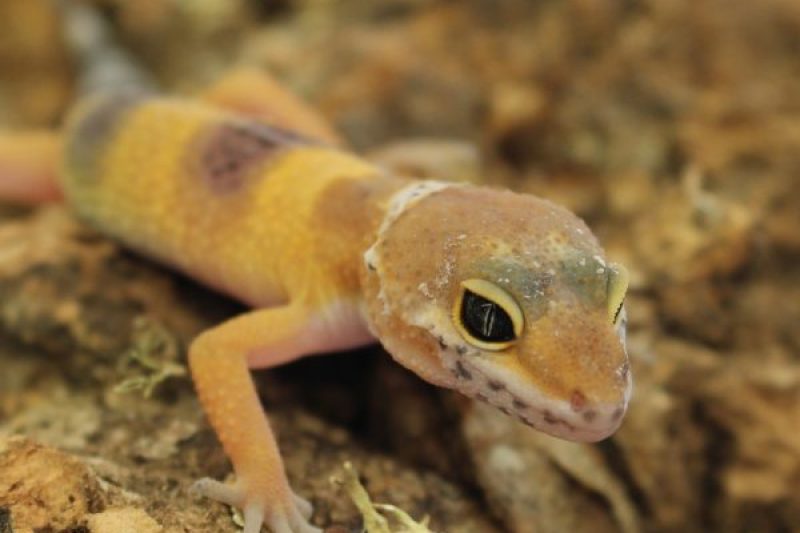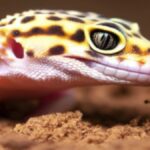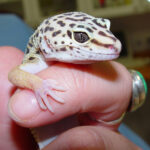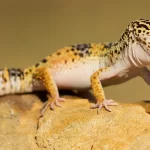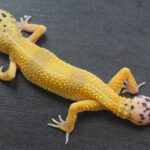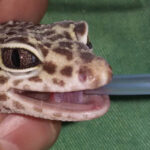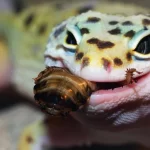When a male and female Leopard gecko is housed together, breeding is almost inevitable. For many owners it is a joy to go through the breeding process. This article will prepare owners for the experience.
Introduction to Leopard gecko breeding
Leopard geckos are successful breeders. Breeding with Leopard geckos is easy and in most cases even unstoppable. Apart from the correct husbandry, only a bit of extra knowledge is required to produce a batch of Leopard gecko babies.
Breeding pairs
In order to breed, an adult male and female Leopard gecko need to be housed together. When the enclosure size allows, one male can be paired with a couple of females. Leopard geckos are seasonally polyestrous. Females can retain sperm for one year. Breeding age (sexual maturity) for Leopard geckos depends on the gender, date of birth and weight, but is generally between 9 and 10 months of age.
Female Leopard geckos can lose a lot of weight during the breeding process and it is therefore advisable to only start breeding when they are fully grown (weighing 45 grams or more) or at least one year of age. Sexing is done by looking at the vent area. Hemipanal bulges and femoral pores will be visible in males while they are absent in females. To prevent Leopard geckos from breeding, smaller females should rather be separated from males until they are the correct size/age and well bodied.
Mating and mating behaviour
The natural breeding season of Leopard geckos is from early spring to autumn. Breeding is seasonal. During the mating season, a breeding pair will show much more interest towards each other, especially the male towards females. Breeding behaviour in males will start off with stalking and circling the female and then getting close to her. There will also be swift tail wagging, wiggling and/or tail vibrations – which can often be heard.
Owners will rarely see the mating process but are typically characterised by the male on top of his female counterpart, biting her neck to hold on for copulation. Their tails will be intertwined to allow the reproductive organs to meet.
Gravid females
After mating was successful, the female Leopard gecko will start to show signs of being gravid. Over the next 16 to 22 days, her abdomen will start to enlarge with eggs. During this period, female Leopard geckos might eat more or eat less than usual. She might also isolate herself more frequently from her cage mate(s).
Laying eggs and incubation
Leopard geckos are oviparous, meaning they lay eggs that hatch outside the body of the female. Females Leopard geckos typically produce a clutch of two eggs at a time. During the course of the breeding season, a total of four to ten clutches of eggs (typically six) can be produced every three to four weeks.
Leopard gecko eggs are whitish, soft-shelled, oval and about the size of a large pea. Once the breeding season begins, a female can lay a clutch of eggs every 15 to 22 days over a four- to five-month period.
Nearing the end of the gravid period, the hide box should be supplied with fresh substrate. At these times, the hide box will also serve as an egg-laying box. The same substrate can be used for both – either moist vermiculite or moist peat or sphagnum moss. During this time the male Leopard gecko should preferably be isolated from the female(s).
After the eggs have been deposited into the egg-laying substrate, they should be transferred to a smaller container with a fresh mixture of moist vermiculite before they are transferred to the incubator. By this time the incubator should be readied and calibrated at a temperature of between 26 and 33 °C / 79 and 91 °F.
Eggs should be monitored regularly, but not frequently. Stick to principles that will cause the least amount of temperature fluctuations for the incubator that is used. Mouldy eggs will not hatch and should be removed and discarded as soon as they appear in order not to affect healthy ones.
Also see
Suitable substrates for Leopard geckos
Leopard gecko egg incubation temperatures
Hatchling Leopard geckos
Viable eggs can take 35 to 89 days to incubate. When babies start to appear, try not to interfere. Only once a baby Leopard geckos have emerged completely from the egg should it be transferred to a larger keeping container.
Hatchling Leopard geckos should never be kept with juvenile and adult Leopard geckos.

